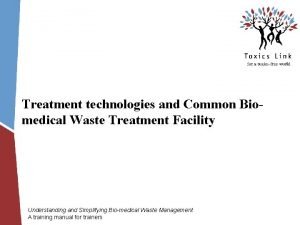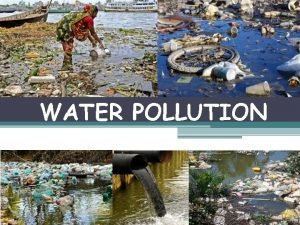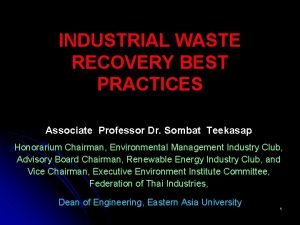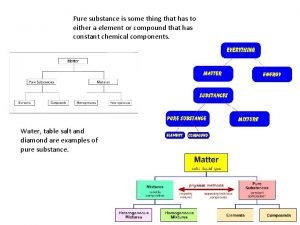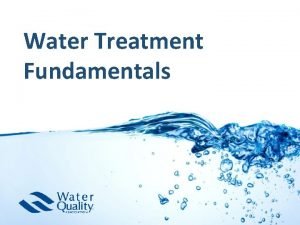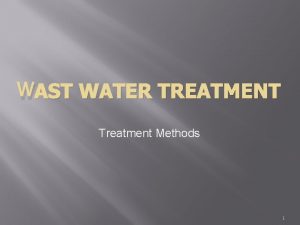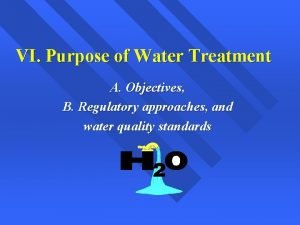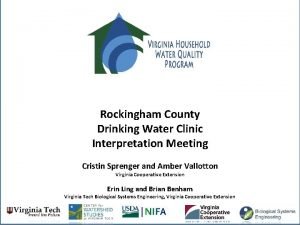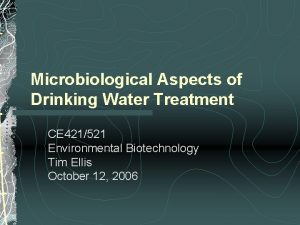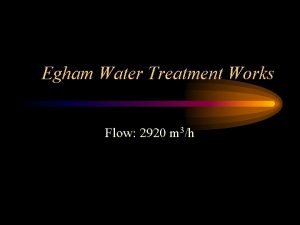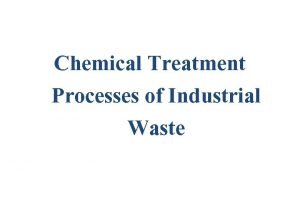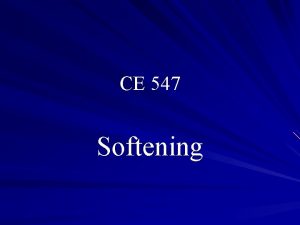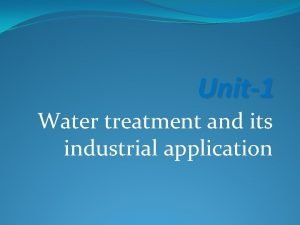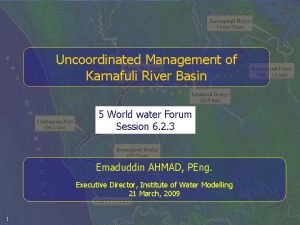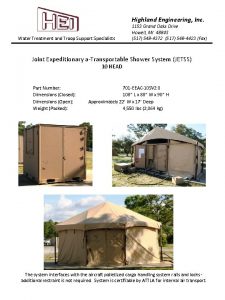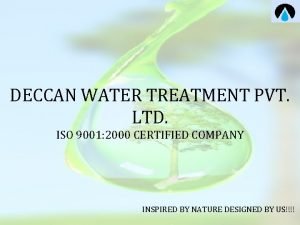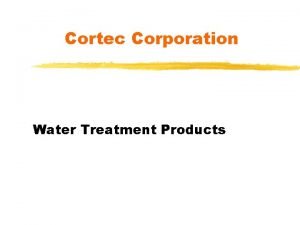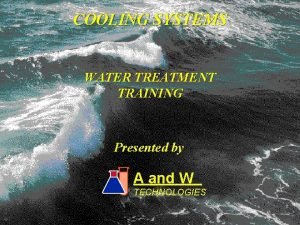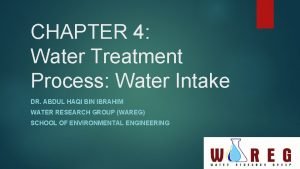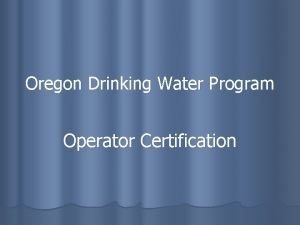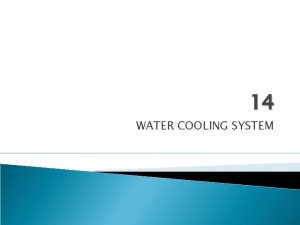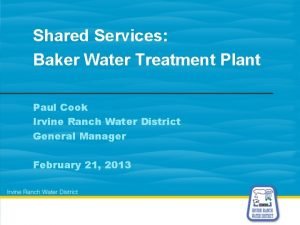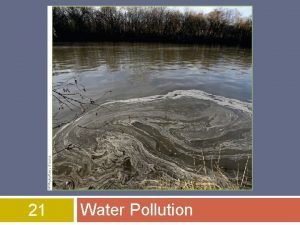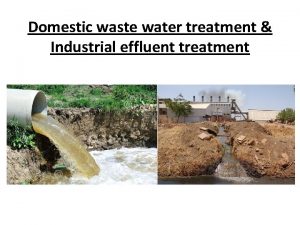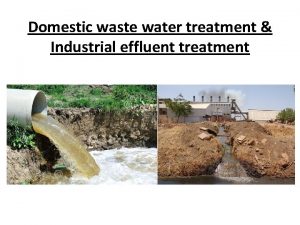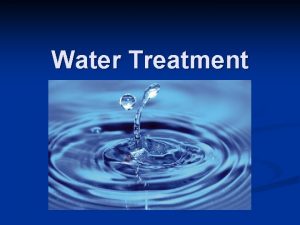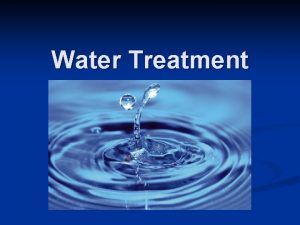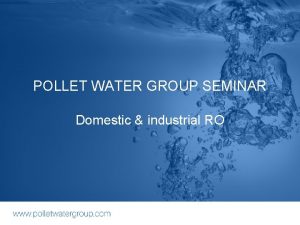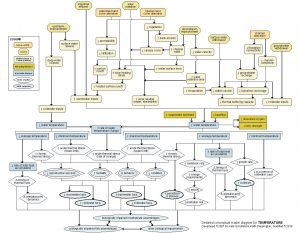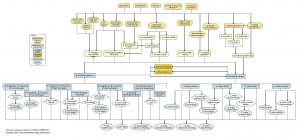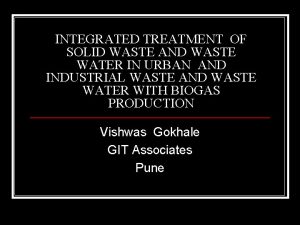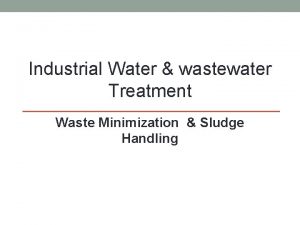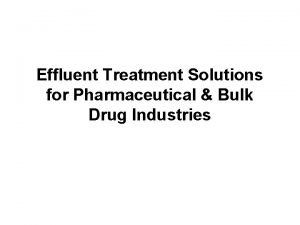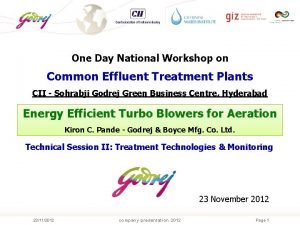Domestic waste water treatment Industrial effluent treatment WASTE





























- Slides: 29

Domestic waste water treatment & Industrial effluent treatment

WASTE WATER TREATMENT (DOMESTIC & INDUSTRIAL) • The use of microorganisms to remove the contaminants from wastewater is largely dependent upon wastewater source and characteristics. • Wastewater is typically categorized into one of the following groups: 1. Municipal wastewater 2. Commercial & Industrial wastewater 3. Agricultural wastewater

• The effluent components may be of chemical, physical or biological nature and they can induce an environmental impact which includes changes in aquatic habitat and in species structure as well as change in biodiversity and water quality. • Since many of the compounds present in effluents are toxic for microorganisms, so pretreatment is very essential. • Biological treatment requires that the effluents must be rich in unstable organic compounds so that the microbes must be able to break down the unstable organic compounds into stable products such as CO 2, CO, NH 3, CH 4, H 2 S etc.


Objective The main objectives of wastewater treatment process can be summarized as: • Reduction of biodegradable organics content (BOD 5) • Reduction of recalcitrant organics • Removal of heavy metals • Removal of compounds containing p and n (nutrients) • Removal of pathogenic microorganisms and parasites

• Biochemical Oxygen Demand (BOD), is the amount of dissolved oxygen needed demanded by aerobic biological organisms to break down organic material present in a given water sample at certain temperature over a specific time period. • The BOD value is most commonly expressed in milligrams of oxygen consumed per litre of sample during 5 days of incubation at 20 °C • BOD can be used as a gauge of the effectiveness of wastewater treatment plants.

COD • BOD is similar in function to chemical oxygen demand (COD), in that both measure the amount of organic compounds in water. However, COD is less specific, since it measures everything that can be chemically oxidized, rather than just levels of biodegradable organic matter.

Biological process • Three major groups of biological processes can be run in combination or in sequence to offer greater levels of treatment: • Aerobic • Anaerobic • Combination of aerobic and anaerobic

1. Aerobic Biotreatment • Often used for municipal and industrial wastewater treatment. • Easily biodegradable organic matter can be treated by this system • Basic reaction in aerobic treatment plant is given Organic material + O 2 CO 2 +H 2 O+ new cells Microbial cells undergo progressive autooxidation of the cell mass: Cells + O 2 CO 2+ H 2 O+NH 3

• The processes can be exploited as suspended (activate sludge) or attached growth (fixed film) systems. Aeration tanks used for the activated sludge process allows suspended growth of bacterial biomass to occur during biological wastewater treatment, while trickling filters support attached growth of biomass. Advanced types of activated sludge systems use pure oxygen instead of air and can operate at higher biomass concentration.

• Biofilm reactors are applied for wastewater treatment in variants such as: trickle filters, rotating disk reactors, airlift reactors. • Domestic wastewaters are usually treated by aerobic activated sludge process, since they are composed mainly of proteins (40 -60%), carbohydrates (25 -50%), fats and oils (10%), urea, a large number of trace refractory organics (pesticides, surfactants, phenols).

BIOLOGICAL WASTEWATER TREATMENT ACTIVATED SLUDGE PROCESS Activated sludge treatment plant Single tank technique Combined process Continuous feed Discontinuous feed (Sequencing batch reactors) BIOFILM PROCESS Submerged biofilm Sprayed biofilm Trickling filter Fixed bed reactors Fluidized bed reactors Soil filter Gravel filter Constructed wetland

2. Anaerobic biotreatment • Anaerobic treatment of wastewater does not generally lead to low pollution standards, and it is often considered a pre-treatment process, devoted to minimization of oxygen demand excessive formation of sludge. • Highly concentrated wastewaters should be treated anaerobically due to the possibility to recover energy as biogas and low quantity of sludge

• Research and practices have demonstrated that high loads of wastewater treated by anaerobic technologies generates - Low quantities of sludge with a high treatment efficiency, - Low capital costs, - No oxygen requirements, - Methane production, - Low nutrient requirements

CO 2, H 2 O Inlet outlet Aerobic 100 kg COD 10 kg COD Treatment Energy 100 KW Sludge 60 kg COD CH 4, CO 2 Inlet outlet Anaerobic 100 kg COD 10 kg COD Treatment Energy 10 KW Sludge 10 kg COD

New developments in anaerobic wastewater treatment • High rate anaerobic wastewater treatment technologies can be applied to treat dilute concentrated liquid organic wastewaters which are discharged from distilleries, breweries, paper mills, petrochemical plants etc. • Even municipal wastewater can be treated using high rate anaerobic technologies. • There also a number of established and emerging technologies with various applications, such as: - a) Sulphate reduction ------for removal and recovery of heavy metals - b) Bioremediation ------for breakdown of toxic pollutants to harmless products.

a) Sulphate reducing process • sulphur-rich wastewaters • Upflow anaerobic sludge blanket (UASB) reactors can be used to treat sulphur-rich wastewaters • SO 42 - + COD HS- + CO 2 sulphate organic substrate disulfide S 2 - + M 2+ MS Sulfide heavy metal metal sulfide (insoluble) HS- + O 2 S 0 + H 2 O disulfide oxygen elemental sulfur

b) Bioremediation • Wastewater treatment using purple nonsulphur bacteria, (Rhodospirillaceae) a sort of photosynthetic bacteria under light and anaerobic conditions is applied to produce a large amount of useful biomass with little carbon dioxide. • The biomass of these bacteria can be utilized for agricultural and industrial purposes, such as a feed for fish and animals, fertilizers.

• Conventional wastewater Treatment Green house gas co 2 Green Energy Organic house gas substances in c. H 4 wastewater Sludge Disposal • Wastewater Treatment by photosynthetic Bacteria Organic substances in wastewater Green house gas co 2 Biomass Reuse

3. Advanced biotreatment • Membrane technology is considered one of the innovative and advance technologies. • In combination with biological treatment, it is applied to organic wastewaters, a large part of which is biodegradable. • In fact, this is the combination of a membrane process like microfiltration or ultrafiltration with a suspended growth bioreactor.

Membrane Separation Activated Sludge Process (MSAS) • It is widely and successfully applied around the world for municipal and industrial wastewater treatment with plant sizes up to 80, 000 population equivalent. • The process efficiency is dependent on several factors, such as membrane characteristics, sludge characteristics, operating conditions. • A new generation of MSAS is the submerged type where membrane modules are directly immersed in an aeration tank. • This aims to significantly reduce the energy consumption by eliminating a big circulation pump typically installed in a conventional MSAS.

• External Membrane Module Membrane module Aeration Tank waste sludge • Submerged Membrane Module Aeration tank Permeate

4. Molecular techniques in wastewater treatment • Although molecular technique applications in wastewater biotreatment are quite new, being developed during the 1990 s and not appearing to be more economically than the established technologies, major applications may include the enhancement of xenobiotics removal in wastewater treatment plants and the use of nucleic acid probes to detect pathogens and parasites. • Among these techniques, the most interesting proved to be cloning and creation of gene library, denaturant gradient cell electrophoresis (DGGE), fluorescent in situ hybridization with DNA probes (FISH).

• Wastewater treatment processes can be improved by selection of novel microorganisms in order to perform a certain action. • However, the use of DNA technology in pollution control showed to have some disadvantages and limitations, such as: - multistep pathways in xenobiotics biodegradation, - limited degradation, - instability of the recombinant strains in the environment, -public concern about release of genetic modified microorganisms etc.

5. Metals removal by microorganisms from wastewaters • Heavy metals come in wastewater treatment plants from industrial discharges, storm water etc. Toxic metals may damage the biological treatment process. • Metals from wastewater such as iron, copper, cadmium, nickel, uranium can be mostly complexed by extracellular polymers produced by several types of bacteria (B. licheniformis, Zooglea ramigera). Subsequently, metals can be accumulated and then released from biomass by acidic treatment. • Nonliving immobilized bacteria, fungi, algae are able to remove heavy metals from wastewater.

• The mechanisms involved in metal removal from waste- water include: complexation and solubilization of metals, precipitation, volatilization, intracellular accumulation of metals, redox transformation of metals, use of recombinant bacteria. • For example, Cd 2+ can be accumulated by bacteria, such as E. coli, B. cereus, fungi (Aspergillus niger). The hexavalent chromium (Cr 6+) can be reduced to trivalent chromium (Cr 3+) by the Enterobacter cloacae strain; subsequently Cr 3+ precipitates as a metal hydroxide. • Some microorganisms can also transform Hg 2+ and several of its organic compounds (methyl mercury, ethyl mercuric phosphate) to the volatile form Hg 0, which is in fact a detoxification mechanism. • The metabolic activity of some bacteria (Aeromonas, Flavobacterium) can be exploited to transform Selenium to volatile alkylselenides as a result of methylation.

Metals Cd Cr(VI) Pb(II) Ni(II) Cr(VI) Cr(III) Organisms Yeasts Saccharomyces cerevisiae A. pullulans B. Cr. laurentii Cy. capitatum H. anomala P. fermentans rubra cerevisiae Sp. roseus S. cerevisiae Candida utilis S. Cerevisiae S. cerevisiae

Metals Organism Living microalgae free in solution Cd(II) Pb(II) Zn(II) Ni(I) Co(II) Mn(II) Mo(I) Chlorella vulgaris Chlorella salina Chlorella homosphaera Scenedesmus obliquus Chlamydomonas reinhardtii Asterionella formosa Fragilaria crotonensis Thalassiosira rotula Cricosphaere elongate Chlorella vulgaris Euglena sp. Chlorella vulgaris Chlorella regularis Chlorella salina Chlorella homosphaera Chlorella regularis T halassiosira rotula Chlorella regularis Chlorella salina Chlorella regularis C hlorella salina Euglena sp. Chlorella regularis Scenedesmus sp

• Thanks
 Effluent pumps haiti
Effluent pumps haiti Water and water and water water
Water and water and water water Freight types
Freight types Biomedical waste management introduction
Biomedical waste management introduction Industrial waste causes
Industrial waste causes Industrial waste recovery
Industrial waste recovery Substance
Substance Water treatment fundamentals
Water treatment fundamentals Wast water treatment
Wast water treatment What are the objectives of water purification
What are the objectives of water purification Water treatment rockingham county
Water treatment rockingham county 421521
421521 Water treatment works near me
Water treatment works near me Chemical oxidation water treatment
Chemical oxidation water treatment Split treatment water softening
Split treatment water softening Caustic embrittlement
Caustic embrittlement Mohra water treatment plant
Mohra water treatment plant Sonoxide
Sonoxide Highland engineering
Highland engineering Deccan water treatment
Deccan water treatment Cortec water treatment
Cortec water treatment Cooling tower water treatment training
Cooling tower water treatment training Intake water treatment process
Intake water treatment process Ce certification sewage treatment works
Ce certification sewage treatment works Oregon drinking water certification
Oregon drinking water certification Jacket water cooling system treatment
Jacket water cooling system treatment Objective of water treatment
Objective of water treatment Baker shared services
Baker shared services Seta plant
Seta plant Water treated from sewage treatment plant
Water treated from sewage treatment plant



